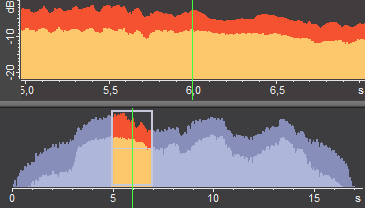Timeline and Waveform
The Waveform and the Timeline are closely related and show the same information, which is how the intensity (or volume) of the recording changes over time. The difference is that the Timeline shows a larger time range than the Spectrogram, while the Waveform always shows the same time range as the Spectrogram. It can be useful to display both views when working with longer recordings, where the Timeline provides an overview over the whole recording, and the Waveform shows a detailed view of the current time range.
If the Waveform is hidden, you can show it by clicking on
→ .
Figure 3.5 shows the Timeline at the bottom, and the Waveform at the top. The Timeline shows the whole recording, which is 17 seconds long. The Time Range Slider at the bottom highlights the range from 5.0 to 7.0 seconds: this is the range shown on the Waveform and on the Spectrogram (which is not shown in this image). The Time Cursor is at 6.0 seconds (this is the green vertical line).
Since the Timeline shows an overview of the entire recording, you can use it to navigate to specific points in your recording. Simply click on it anywhere to jump to that position. You can also move the Time Range Slider with the mouse when you point at the middle of the slider, where the mouse cursor changes into a hand.
You can zoom the range of values shown on the Waveform and Timeline through the amplitude scale by pointing the mouse cursor at it and then using the mouse wheel, or by pressing the and keys. You can also left-click and drag the scale to scroll its range. This is explained in more detail in the chapter scrolling and zooming.
The Timeline itself can be zoomed by pointing at it and then holding and using the mouse wheel. You can also show the in the menu and use that to zoom the Timeline.
When the Waveform is zoomed out to show a relatively long time range, each pixel on the screen shows the maximum amplitude for all the audio samples represented by the time range of that pixel. When you zoom in very close, the displayed time range becomes so small that individual audio samples become visible. In that case the Waveform looks like an oscilloscope:
The Waveform and Timeline can display the intensity of the recording in various ways. If you right-click on the Waveform or the Timeline, you can select one of these display modes:
| Layout | Scale mode | Example |
|---|---|---|
| Symmetric | linear |  |
| log |  | |
| Skyline | linear |  |
| log |  |
Table 3.2. The same recording in various waveform display modes
Table 3.2 illustrates the four display modes. The layout determines if the view is symmetrical or not. In the skyline mode, only the upper half of the scale range is shown.
The scale mode determines if the intensity is shown on a linear or a log scale. Depending on what you want to do, one mode may be more useful than the other. Notice how in the bottom row of Table 3.2 the beginning of the recording is not shown. That is because the log scale has no lower end (it would be at minus infinity), and therefore small values are hidden in this mode. On the other hand, the display of intensity in log mode is more similar to the way we hear volumes than in the linear mode.
| Linear Amplitude | Log Intensity |
|---|---|
| Shows entire range from 0 to 1. | Shows intensity from loudest range (at 0 dB) towards some cutoff point, depending on scale zoom. |
| Very quiet passages are still visible. | Quiet passages may be hidden. |
| Does not accurately represent human perception and makes it hard to compare the volume of different sections. | Is a better model of human perception and allows for better volume comparisons. |
| Good for editing and for general navigation through a recording. | Good for analyzing the dynamic range of a recording and for inspecting variations in loudness. |
Table 3.3. Waveform scale mode comparison


